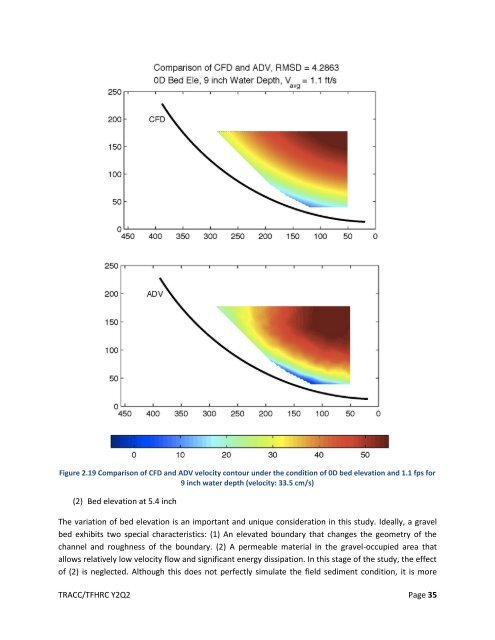Computational Mechanics Research and Support for Aerodynamics ...
Computational Mechanics Research and Support for Aerodynamics ... Computational Mechanics Research and Support for Aerodynamics ...
Figure 2.19 Comparison of CFD and ADV velocity contour under the condition of 0D bed elevation and 1.1 fps for 9 inch water depth (velocity: 33.5 cm/s) (2) Bed elevation at 5.4 inch The variation of bed elevation is an important and unique consideration in this study. Ideally, a gravel bed exhibits two special characteristics: (1) An elevated boundary that changes the geometry of the channel and roughness of the boundary. (2) A permeable material in the gravel-occupied area that allows relatively low velocity flow and significant energy dissipation. In this stage of the study, the effect of (2) is neglected. Although this does not perfectly simulate the field sediment condition, it is more TRACC/TFHRC Y2Q2 Page 35
consistent with the lab test setup, for which a single layer of gravel is laid onto the solid flume bed to represent the roughness of the gravel bed. Figure 2.20 shows the sketch of the experimental model (left) and the CAD model of culvert section geometry (right). The dimples shown in the CAD model were created by a 2-D periodical function that yields a similar roughness as that of natural bed with specified gravel size. Figure 2.20 Sketch of experimental model (left) and CAD model of culvert section (right) under the situation of bed elevation at 5.4 inch The CFD simulations for clean culvert pipes described in the previous section were repeated on the model shown in Figure 2.20. Results were compared in Figure 2.21 through Figure 2.23. Similarly, the trough cross-section (the largest cross-sectional area) was used for the comparison between CFD and PIV. Detailed parameters are given in Table 2.2. TRACC/TFHRC Y2Q2 Page 36
- Page 1 and 2: ANL/ESD/12-27 Energy Systems Divisi
- Page 3 and 4: ANL/ESD/12-27 Computational Mechani
- Page 5 and 6: List of Figures Figure 2.1: Bridge
- Page 7 and 8: Figure 2.35: Two different transiti
- Page 9 and 10: 1. Introduction and Objectives The
- Page 11 and 12: 2. Computational Fluid Dynamics for
- Page 13 and 14: flat surface assumption is good exc
- Page 15 and 16: conditions from Example 1 defined i
- Page 17 and 18: scour rate is initially highest nea
- Page 19 and 20: Figure 2.6 Dividing streamline posi
- Page 21 and 22: 2.1.3. Resolving Issues of the Seco
- Page 23 and 24: educe the rate of increase for y wh
- Page 25 and 26: Design Scour Depth 0.400 0.350 0.30
- Page 27 and 28: extend the impact of the findings t
- Page 29 and 30: Table 2.2 Contour plots comparing C
- Page 31 and 32: Figure 2.14 Comparison of CFD and P
- Page 33 and 34: Figure 2.16 Comparison of CFD and P
- Page 35: Figure 2.18 Comparison of CFD and P
- Page 39 and 40: Figure 2.22 Comparison of CFD and P
- Page 41 and 42: Figure 2.24 Comparison of CFD and P
- Page 43 and 44: Figure 2.26 Comparison of CFD and P
- Page 45 and 46: Figure 2.28 Comparison of CFD and P
- Page 47 and 48: Figure 2.30 Comparison of CFD and P
- Page 49 and 50: Figure 2.32 Comparison of CFD and P
- Page 51 and 52: RMSD area area ( V1 V2 ) n area 2
- Page 53 and 54: 2. Marian Muste, Hao-Che Ho, Daniel
- Page 55 and 56: Honeycomb Streamline Trumpet Unifor
- Page 57 and 58: (a) Streamline trumpet transition c
- Page 59 and 60: 2.6. Training and Technology Transf
- Page 61: Figure 2.40: Announcement for CFD t
Figure 2.19 Comparison of CFD <strong>and</strong> ADV velocity contour under the condition of 0D bed elevation <strong>and</strong> 1.1 fps <strong>for</strong><br />
9 inch water depth (velocity: 33.5 cm/s)<br />
(2) Bed elevation at 5.4 inch<br />
The variation of bed elevation is an important <strong>and</strong> unique consideration in this study. Ideally, a gravel<br />
bed exhibits two special characteristics: (1) An elevated boundary that changes the geometry of the<br />
channel <strong>and</strong> roughness of the boundary. (2) A permeable material in the gravel-occupied area that<br />
allows relatively low velocity flow <strong>and</strong> significant energy dissipation. In this stage of the study, the effect<br />
of (2) is neglected. Although this does not perfectly simulate the field sediment condition, it is more<br />
TRACC/TFHRC Y2Q2 Page 35



